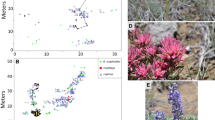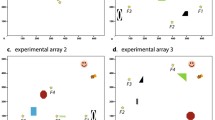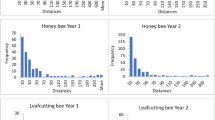Abstract
Pollinators whose foraging habitats consist of several plant types (species or morph) may continue to choose the plant type last visited because information about the type of plant last visited dominates over all other memory contents, in particular of short-term memory. In this study, I extracted this overstrike effect on the plant choices of pollinators by analyzing patterns of visitation sequences within a single round-trip between the hive and foraging patch (bout). First, I simulated the visitation sequences within single bouts with a model to show how factors, including the bees’ plant-type preferences, the arrangement of plants and the effect of overstrike on short-term memory, affect visitation sequences. Here, bees are assumed to forage in a patch consisting of two plant types (H and L). The model predicts that only the effect of overstrike on short-term memory causes assorted visitation sequences according to plant type (within-bout flower constancy). That is, if the overstrike-effect on short-term memory is the primary determinant of plant choice, then bees will fly to a type-L plant after visiting a type-L plant even if they predominantly visit type-H plants and vice versa. Next, I investigated individual bumblebees’ visitation sequences at a patch of artificial inflorescences with a set-up similar to that assumed in the model. Two types of inflorescences were arranged on a Cartesian grid. Assorted visitation sequences according to inflorescence type were observed, depending on the distances among inflorescences. This result supports the hypotheses that bees fly to the same plant type as that last visited because short-term memory is displaced (overstruck) with information about the most recently visited plant type.






Similar content being viewed by others
References
Bateman AJ (1951) The taxonomic discrimination of bees. Heredity 5:271–278
Broström (2003) Generalized linear models with random intercepts. http://www.stat.umu.se/forskning/reports/glmmML.pdf
Chittka L, Gumbert A, Kunze J (1997) Foraging dynamics of bumble bees: correlates of movement within and between plant species. Behav Ecol 8:239–249
Chittka L, Thomson JD, Waser NW (1999) Flower constancy, insect psychology, and plant evolution. Naturwissenschaften 86:361–377
Chittka L, Spaethe J, Schmidt A, Hichelsberger A (2001) Adaptation, constraint, and chance in the evolution of flower color and pollinator color vision. In: Chittka L, Thomson JD (eds) Cognitive ecology of pollination. Cambridge University Press, Cambridge, pp 106–126
Dukas R (1995) Transfer and interference learning in bumble bees. Anim Behav 49:1481–1490
Dukas R, Real AR (1993) Learning constraints and floral choice behaviour in bumble bees. Anim Behav 46:637–644
Gegear RJ, Laverty TM (2001) The effect of variation among floral traits on the flower constancy of pollinators. In: Chittka L, Thomson JD (eds) Cognitive ecology of pollination. Cambridge University Press, Cambridge, pp 106–126
Giurfa M (1993) The repellent scent-mark of the honeybee Apis mellifera and its role as communication cue during foraging. Insect Soc 40:59–78
Giurfa M, Vorobyev M, Kevan P, Menzel R (1996) Detection of colored stimuli by honeybees: minimum visual angles and receptor specific contrast. J Comp Physiol A 178:699–709
Goulson D (2000) Are insects flower constant because they use search images to find flowers? Oikos 88:547–552
Goulson D, Hawson SA, Stout JC (1998) Foraging bumble bees avoid flowers already visited by conspecifics or by other bumblebees species. Anim Behav 55:199–206
Greggers U, Menzel R (1993) Memory dynamics and foraging strategies of honeybees. Behav Ecol Sociobiol 32:17–29
Heinrich B (1976) Foraging specialization of individual bumblebees. Ecol Monogr 46:105–128
Heinrich B (1979) “Majoring” and “minoring” by foraging bumblebees, Bombus vagans: an experimental analysis. Ecology 60:245–255
Hill PSM, Wells PH, Wells H (1997) Spontaneous flower constancy and learning in honey bees as a function of color. Anim Behav 54:615–627
Jones KN (1997) Analysis of pollinator foraging: test for non-random behaviour. Funct Ecol 11:255–259
Lewis AC (1986) Memory constraints and flower choice in Pieris rapae. Science 232:863–865
Lunau K, Wacht S, Chittka L (1996) Colour choices of naive bumble bees and their implications for colour perception. J Comp Physiol A 178:477–489
MacArthur RH, Pianka ER (1966) On optimal use of a patchy environment. Am Nat 100:219–223
Marden JH, Waddington KD (1981) Floral choices by honeybees in relation to the relative distances to flowers. Physiol Entomol 6:431–435
Menzel R (1979) Behavioural access to short-term memory in bees. Nature 281:368–369
Menzel R (1999) Memory dynamics in the honey bees. J Comp Physiol A 185:323–340
Menzel R (2001) Behavioral and neural mechanisms of learning and memory as determinants of flower constancy. In: Chittka L, Thomson JD (eds) Cognitive ecology of pollination. Cambridge University Press, Cambridge, pp 106–126
Menzel R, Müller U (1996) Learning and memory in honeybees: from behavior to neural substrates. Annu Rev Neurosci 19:379–404
R Development Core Team (2004) R: a language and environment for statistical computing. R Foundation for Statistical Computing, Vienna. ISBN 3-900051-00-3. http://www.R-project.org
Thomson JD, Slatkin M, Thomson BA (1997) Trapline foraging by bumble bees. II. Definition and detection from sequence data. Behav Ecol 8:199–210
Venables WN, Ripley BD (2002) Modern applied statistics with S, 4th edn. Springer, Berlin Heidelberg New York
Waser NM (1986) Flower constancy: definition, cause and measurement. Am Nat 127:593–603
Wilson P, Stine M (1996) Floral constancy in bumble bees: handling efficiency or perceptual conditioning? Oecologia 106:493–499
Acknowledgements
I thank G. Kudo for his guidance in planning and fruitful discussion of this study; S. Sakai for his critical comments on the manuscript; and T. Kubo for his assistance in simulating the model. I also acknowledge the advice of M. Yoneda on keeping bumblebee colonies; the assistance of T. Osawa, H. Kamauch, S. Kosuge, K. Mori, T. Tani, and A.M. Ishii in collecting the data; and the support of T.Y. Ida throughout this study. This study was in part supported by a fellowship (no. 0124) of JSPS for the Promotion of Science for Young Scientists. The experiment complies with the laws of Japan, the country in which it was performed.
Author information
Authors and Affiliations
Corresponding author
Additional information
Communicated by M. Giurfa
Appendix
Appendix
Possible range of C p
If N H −N L >1 or N L −N H > 1, constant flights occur at least once. More generally, the number of constant flights (N HH +N LL ) is equal to or larger than |N H −N L |−1. Also, N HH +N LL is equal to or smaller than the total flight (N XX’ ). Thus,
Because N XX’ =N X −1, eqn. A1 can be transformed as
If N X is large,
Accordingly, if N X is large, the possible range of C p (see eqn. 3 in the text) becomes
Rights and permissions
About this article
Cite this article
Ishii, H.S. Analysis of bumblebee visitation sequences within single bouts: implication of the overstrike effect on short-term memory. Behav Ecol Sociobiol 57, 599–610 (2005). https://doi.org/10.1007/s00265-004-0889-z
Received:
Revised:
Accepted:
Published:
Issue Date:
DOI: https://doi.org/10.1007/s00265-004-0889-z




